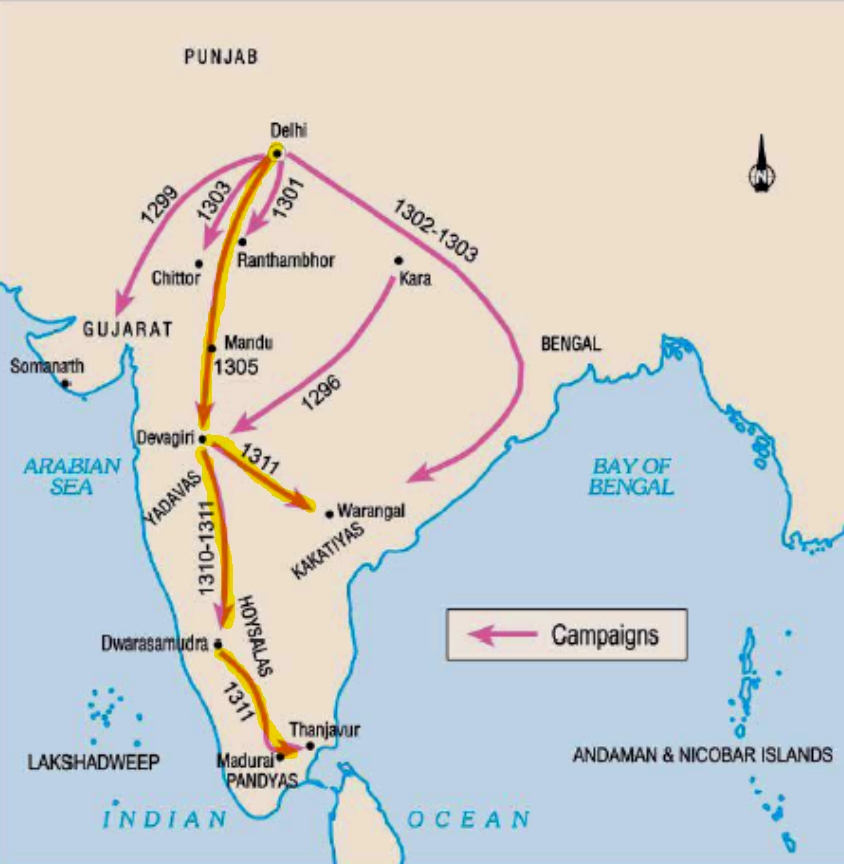Malik Kafur- History, Gender, Relationship with Khilji & Dealth Reason
Who was Malik Kafur?
Malik Kafur, also known as Taj al-Din Izz al-Dawla, was a slave general of the Delhi Sultanate ruler Alauddin Khilji (r. 1296–1316).
- Before his tenure with Al-ud-din Khilji, Kafur was the slave of a wealthy Gujarati Khwaja in the Khambat region.
- The Khwaja is presumed to have bought Kafur, who was a eunuch by gender and of great physical beauty, for 1000 dinars, so Kafur was also called ‘hazar-dinari‘ (al-Alfi in Arabic).
- The traveller named Ibn Batuta also substantiates the fact by referring to Kafur as “Al-Alfi”, which is equivalent to “hazar-dinari” in Arabic.
- Based on Barani’s description, scholars salim kidwai and Ruth vanita believed that Alaudin and malik Kafur were in a homosexual relationship.

History of Malik Kafur:
According to some historians, Malik Kafur was born to a Hindu Family and was converted to Islam later in his life. In his youth, Kafur was a eunuch slave of great physical beauty.
- Aladdin’s general, Nusrat Khan, captured Malik Kafur during his Gujarat campaign (the port city of Khambhat) of 1299. Malik Kafur was brought to Delhi at the service of the Sultan.
- Nusrat Khan presented him to Sultan Alauddin in Delhi, who favoured Kafur, according to Isami, and promoted him as a military commander and wise counsellor.
- Very soon, Malik Kafur rose to prominence due to his wise counsel to the king and his ability as a military commander. Kafur commanded the Khilji’s forces against the Mongols and defeated them in 1306 CE.
Malik Kafur invasion
Malik Kafur carried out several successful invasions and helped advance the Alauddin Khilji treasury.
- Malik Kafur’s first stint as a military commander was in 1306 when Malik Kafur sent to Punjab region to repulse a Mongol invasion from the Chagatai Khanate, which he accomplished successfully.
- The imperialist ambitions of Alauddin were not satisfied with the conquest of the north. He was determined to conquer the South as well. The wealth of the southern kingdoms attracted him.
- Therefore, his next mission as a commander general was a series of great military raids into the Deccan and southern India that laid the foundations of Muslim power in that region.
- Malik Kafur carried out the Delhi Sultanates Deccan and Southern India campaigns:
|
Malik Kafur’s Campaign in the Deccan and Southern India |
|
|
Kingdom |
Year (CE) |
|
Yadavas |
1308 |
|
Kakatiyas |
1310 |
|
Hoysalas |
1311 |
|
Pandyas |
1311 |

These campaigns resulted in tremendous war booty for the Delhi Sultanate.
- Malik Kafur also invaded the Yadava kingdom of Devagiri between 1313 and 1315 CE and took its king, Ramachandra, to capital Delhi with rich spoils.
- Alauddin sent him on an expedition in 1309 to the kakatiya kingdom, which was also accomplished successfully by Kafur who returned to Delhi with tremendous amount of wealth. It is said that the precious Koh-i-Noor diamond was also among the loots, which later became part of the British crown jewel.
- During his expedition to warangal (Kakatiya’s capital), he came to know about the wealth of the southern region of India, and he asked Alauddin to lead an expedition there, which was granted.
- The Malik Kafur subjugated the Dwarsamudra, the Hoysala, and the Pandya kingdom and obtained a huge treasure, horses and elephants in 1311.
- Malik Kafur led one more expedition to Devagiri and annexed it to the Delhi Sultanate. Kafur served as Alauddin’s governor of devagiri.
Malik Kafur’s death:
- Kafur recalled from devagiri when Alauddin was seriously ill; after Alauddin’s death, Malik Kafur tried to usurp control by appointing Alauddin’s minor son, Shihab Uddin omar, as a puppet monarch.
- However, malik kafur’s regency lasted for about a month when Kafur sent a group of assassins to finish off Mubarak khan, Alauddin’ third son. But Mubarak Khan countered this by bribing the men sent to kill him. The assassin returned and beheaded Kafur instead.
- This also marked as the end of the khiljis. A series of place coups and murders followed until the Delhi throne finally passed into the hands of Tughlaqs.
- Former bodyguards of Alauddin Khilji killed Malik Kafur as he tried to assert control over the empire after Ala-ud-din’s death.
Conclusion
Malik Kafur was a powerful commander who played a key role in expanding the Delhi Sultanate’s territories and establishing its dominance over much of the Indian subcontinent. Despite his controversial legacy, he is remembered as one of the most successful military commanders of the empire, and his administrative and economic reforms helped lay the groundwork for future growth and prosperity.
FAQ’s Related to Malik Kafur
What was Malik Kafur’s background?
Malik Kafur was a Hindu boy captured from Gujarat, who became a slave and eunuch in the Delhi Sultanate. He was bought by Sultan Alauddin Khilji and rose to become a trusted general.
What was Kafur’s greatest military achievement?
His greatest military achievement was the successful southern campaigns, where he led the Delhi Sultanate’s armies into the Deccan and South India, reaching as far as Madurai.
What were some of Kafur’s administrative and economic reforms?
Kafur implemented reforms that included restructuring the administrative setup, centralizing military power, and managing war spoils and revenues efficiently to strengthen the sultanate’s economy.
Malik Kafur was the general of?
Malik Kafur was the general of Alauddin Khilji, the Sultan of Delhi from the Khilji dynasty.
Malik Kafur and khilji relationship
Malik Kafur was a slave who turned general under Alauddin Khilji Regime ( The Sultan of Delhi). Political allegiance and mutual trust defined their relationship, and Kafur was a major force in Khilji’s administration, particularly when it came to military and administrative affairs.






![Bilhana- 11Th Century Kashmiri Poet [Upsc Notes] | Updated July 14, 2025 Bilhana- 11Th Century Kashmiri Poet [Upsc Notes]](https://www.99notes.in/wp-content/uploads/2023/03/bilhana-99notes-upsc-768x512.webp)